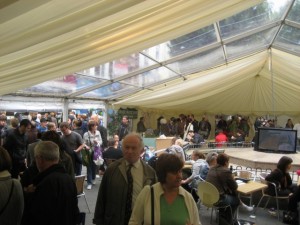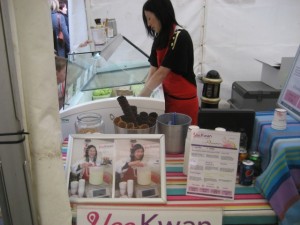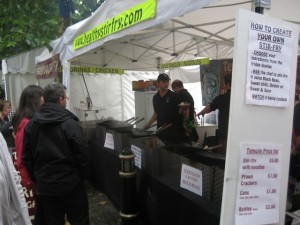Last Saturday was the first weekend of this year’s Food Festival which kicks off with the star event (for me at least), the 2010 Whisky Lounge Whisky Festival. To try to spread the word, it’s split up into two sessions this time, 4 hours in the afternoon, an hour off for the exhibitors to catch their breath and then 4 hours into the evening.
I didn’t want to miss out on the rest of the festival though, so I started mid afternoon with a demonstration from Temujin restaurant, who specialise in totally customised stir fries. The chef, who originally hailed from Zimbambwe, was clearly used to teaching a young audience, taking great care over explaining different colours of chopping boards and keeping raw meat apart from cooked. I’m not sure I’ll be duplicating his recipes at home though, our local supermarkets don’t yet stock farmed crocodile steaks. He knew his audience well, I was surprised how many people in the audience hadn’t come across ginger root before and thought it exotic and spicy. He had some interesting numbers to share, a professional gas powered wok burner gets through about 60,000 BTUs an hour into a single wok. No wonder it cooks through in 2 and a half minutes flat! For a comparison, a good home range might get through 20,000 BTUs per hour if all 5 rings are going at once.
That was followed by a wander through the stands on Parliament Street to see what this year would bring. In their usual corner by M&S were Kippers By Post (.com), complete with a couple of market sized smoking huts to keep the smells wafting and make sure that demand is kept supplied. I’m not a fan myself, they’re just a little too fishy for my taste, but they’re an excellent example of picking one thing and doing it well. The fountain has been roofed over by a large tent, containing a variety of places to graze from, as well as a portable pub. One very topical stand was selling Yee Kwan‘s oriental inspired ice creams and sorbets, which confirmed my suspicions that it’s possible to make ginger ice cream and that lemongrass is just fine to infuse into syrup when making a sorbet. Watch this space.
A generous vension burger provided an early evening bite whilst I wandered over to the demonstration tent for the twilight chocolate session. The head chef from a nearby hotel showed us how to hand make ganache chocolates and how easy it is to make a popular type of branded aerated chocolate bar. Luckily I can read the notes I made this early in the evening, because there were yet more numbers to keep track of. Chocolate is a precise science!
So, a base ganache mix is 640g of 50-60% chocolate, 250g of cream, 70g glucose and 60g of a liqueur such as Grand Marnier or Kirsch. Boil the cream to sterilise it, makes the finished product keep that much longer. Mix in the glucose to the cream, then let it start to cool. Use the heat within the cream to melt the chocolate through the mixture. Chocolate must not be heated above 45C. Likewise, chocolate and water don’t mix, so be careful of condensation when setting in the fridge. Stir in a handful of unsalted butter to give the chocolate a shine and to help it stay set at room temperature. Pour into a greased, lined tray to set for a few hours. Then cut into squares. You can cover your ganache in a variety of things, cocoa powder or ground up nuts are popular choices. To make the covering stick to the ganache, you need yet more chocolate to use as glue. This time the melted choc should be at 32C so that it just covers the cubes. Use gloves, as this is a sticky operation!
To make bubbly chocolate, you need one of the professional metal cream whipping bottles that you see on the TV. Melt about 1kg of good milk 35-40% choc. Don’t use dairy milk and friends because they’ve got a high vegetable fat content that doesn’t play nice. Pour into the bottle and use two cylinders of gas to charge it. Shake up the melted choc through the gas, then spray it all out into a greased, lined tray and leave it to very gently set. don’t bash it, or you’ll knock the bubbles out.
He paid careful attention to tempering his chocolate by gradually cooling it by working the choc with a scraper or spatula on a marble slab. This does things to the crystal size and alignment that gives the chocolate its glossy finish and a good clean snap. Otherwise it’ll crumble.




